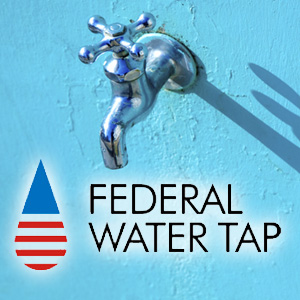Federal Water Tap, December 21: White House Announces Water Innovation Strategy
The Rundown
Obama administration wants to jumpstart water technology. Congressional budget deal clinches water funding while a separate rural water bill passes Congress. An Arkansas representative wants to incentivize groundwater conservation. Government watchdog chides the EPA’s promotion of the Clean Water Rule on social media. Federal officials tell Colorado River states to fix chronic water deficits. New Orleans gets a Hurricane Katrina payout. Dead trees don’t necessarily mean more water in rivers.
“I’m optimistic at the progress that we’ve made so far, but we need to be very transparent about the risks we face and think through solutions. We feel it’s very important to stay on track and get it resolved.” — Deputy Interior Secretary Michael Connor, talking about a chronic water shortage on the Colorado River Basin. More water has been allocated than is available. Connor suggested that the basin states agree to eliminate the deficit, or federal officials will step in to manage the river.
By the Numbers
$US 300 million: Funding for the Great Lakes Restoration Initiative, included in the 2016 budget deal.
$US 1.2 billion: Payment from the Federal Emergency Management Agency to New Orleans to repair damage from 2005 Hurricane Katrina. Roughly 10 percent of the funds will be used for water and sewer projects. (Times-Picayune)
Studies and Reports
Water Recycling Report
The risks to human health and the environment from reusing water from showers and sinks, and from storm drains ought to be analyzed more closely, according to the nation’s premiere science body.
The National Academy of Sciences says that greywater and stormwater can play a significant role in increasing the nation’s water supply, but regulations have not kept up with new technologies.
Tree Deaths and River Flow
Scientists thought that the death of trees weakened by bark beetles in the headwater basins of the Colorado River would increase the amount of water in rivers. According to a new U.S. Department of Agriculture study, they were wrong. Evaporation from formerly shaded ground increased as did water use by other vegetation.
News Briefs
White House on Water
The Obama administration wants a larger role for technology in patching the country’s water supply problems. Its strategy is two-fold, according to a policy paper published last week.
The White House wants to increase the efficiency of existing systems, which will stretch supplies further. It is hoped that this focus on efficiency will prompt companies, universities, and investors to put more money into researching and developing the next generation of water-saving technologies.
The emphasis on technology goes hand-in-hand with better management and wise policies, the paper notes.
Water Investment Center
Along with the White House announcement, the Interior Department said that it will create a Natural Resources Investment Center. The center will work with the private sector to increase investment in water infrastructure and land conservation. Martin Doyle, a professor of river science and policy at Duke University, is the center’s first fellow.
Budget Deal
Congress approved a $US 1.1 trillion spending plan for 2016. Water infrastructure groups praised the deal for allocating $US 1.4 billion to the Clean Water State Revolving Fund, which provides low-interest loans for sewer and stormwater projects. Green groups were pleased that policy riders to overturn the Obama administration’s Clean Water Act interpretation were eliminated. Other items in the bill include:
- Three-year reauthorization of the Land and Water Conservation Fund. The fund, which uses royalties from offshore oil and gas production for parks, trails, wetlands, and more, will distribute $US 450 million in 2016, up 50 percent from recent spending levels. Congress allowed the fund to expire in September;
- Prohibition on using the Arizona & California Railroad Company’s right of way for the construction of a groundwater pipeline, which has been proposed by the company Cadiz, unless the Interior Secretary approves it;
- $US 100 million to water agencies in Jordan;
- $US 400 million for water supply and sanitation abroad;
- $US 345 million for projects to reduce flood risk on the Mississippi River, below Cape Girardeau, Missouri;
- $US 49.5 million for the settlement of Indian water rights claims, an Obama administration priority.
Rural Water Systems Bill
President Obama signed a bill that authorizes $US 15 million per year to be spent on technical assistance for water systems that serve fewer than 10,000 people. The act was introduced by Sen. Roger Wicker (R-MS).
EPA Wrongdoing
EPA officials broke the law by using social media to promote the agency’s Clean Water Act rule, according to the Government Accountability Office, an internal watchdog.
The violation occurred when EPA used a feature on Twitter called a “Thunderclap,” which sends out a pre-planned tweet if a certain threshold of followers agrees to participate. Nine hundred eighty accounts that follow the EPA on Twitter agreed to do so, which exceeded the 500-account threshold. The GAO said that this activity, because the Thunderclap tweet would come from a second party and not the EPA, which wrote the language, constituted “covert propaganda.”
On the Radar
White House Water Summit
The Obama administration will host a national water summit on March 22, 2016. The administration is interested in highlighting the use of innovative science and technology to bring about solutions.
Submit recommendations by January 31 using the form in the link above.
Tax Break for Saving Groundwater
Rep. Eric Crawford (R-AR) introduced a bill to give farmers a financial incentive. The Groundwater Conservation Incentive Act allows farmers to deduct the cost of equipment that saves groundwater. Arkansas is the nation’s third-largest user of groundwater and the eastern part of the state is experiencing severe declines in aquifer levels.
Federal Water Tap is a weekly digest spotting trends in U.S. government water policy. To get more water news, follow Circle of Blue on Twitter and sign up for our newsletter.
Brett writes about agriculture, energy, infrastructure, and the politics and economics of water in the United States. He also writes the Federal Water Tap, Circle of Blue’s weekly digest of U.S. government water news. He is the winner of two Society of Environmental Journalists reporting awards, one of the top honors in American environmental journalism: first place for explanatory reporting for a series on septic system pollution in the United States(2016) and third place for beat reporting in a small market (2014). He received the Sierra Club’s Distinguished Service Award in 2018. Brett lives in Seattle, where he hikes the mountains and bakes pies. Contact Brett Walton






Leave a Reply
Want to join the discussion?Feel free to contribute!